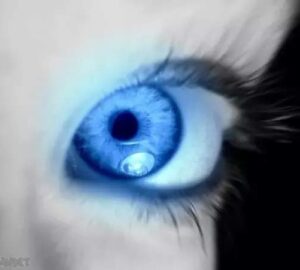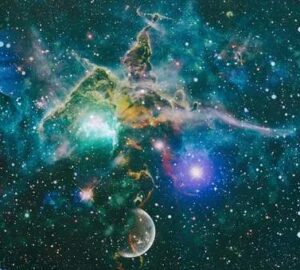Pareidolia is the phenomenon where people see recognizable shapes, forms, or images in otherwise random stimuli. For example, seeing animal shapes in cloud formations, faces in inanimate objects, or religious figures in food items. But is this truly a spiritual gift or simply a quirk of human perception?
What is Pareidolia?
Pareidolia (/pærɪˈdoʊliə/ parr-i-DOH-lee-ə) is a psychological phenomenon where the mind responds to a stimulus by perceiving a familiar pattern, form, or meaning where none exists.
Some common examples of pareidolia include:
- Seeing faces or figures in cloud formations
- Seeing a face on the surface of the moon
- Seeing religious figures in food items or everyday objects
- Hearing hidden messages in music when played backwards
- Seeing animals or shapes in rock formations or landscapes
Pareidolia often involves seeing faces, animals, or mythological creatures in random images. The mind tries to find meaning by matching the random shapes to known forms or patterns.
Why Does Pareidolia Happen?
Pareidolia is thought to be related to the innate human ability to recognize faces and patterns. The brain processes sensory information, finds patterns it recognizes, and matches it to something familiar. This helps the brain organize random stimuli and make sense of the world around us.
Some theories suggest pareidolia is an evolutionary byproduct – a tendency to spot patterns that might indicate a threat or aid our survival. Seeing a predator or a friendly face in the environment could offer an evolutionary advantage.
Our brains are also wired to look for meaning, so pareidolia helps us assign significance to random events. Humans have a tendency to look for meaningful connections and patterns even where none exist.
Is Pareidolia a Spiritual Experience?
For some people, episodes of pareidolia seem deeply spiritual. Seeing religious figures and symbols appear from random shapes can feel like a divine sign or message. But is pareidolia really some kind of supernatural experience?
Supporting Arguments
There are a few reasons why some see pareidolia as a spiritual gift:
It Can Represent Confirmation Bias
People who have strong religious beliefs may interpret random images as spiritual confirmation. If you deeply believe in a religious figure or deity, your mind is already primed to recognize their image. This confirmation bias causes you to assign special meaning to randomness.
It May Reflect Emotional Needs
Similarly, pareidolia may expose emotional needs. When stressed or dealing with grief, the mind seeks comfort through meaningful patterns. Seeing a lost loved one’s face or a protective religious figure emerges from that emotional need.
It Reveals Something About Perception
Our perception is not an objective recreation of the world – we each experience reality somewhat subjectively. So what one person sees as a random shape, another witnesses as deeply meaningful. Their neurological wiring causes them to have a different perceptual experience. In that sense, pareidolia reveals the uniqueness of each person’s reality.
Counter Arguments
However, there are also reasons why pareidolia likely isn’t supernatural:
It’s Predicted By Science
Pareidolia is well documented and scientifically predictable. We know the brain seeks out patterns and forms – there’s nothing mystical about it. Predictable natural phenomena are not usually considered spiritual gifts.
It Happens Across Cultures & Beliefs
Pareidolia is cross-cultural and universal. All humans experience it regardless of faith or beliefs. There’s nothing uniquely spiritual about seeing a face in a stained wall compared to seeing Mother Mary in a burrito. The underlying mechanism is the same.
It Can Be Induced Deliberately
We can also prompt the experience of pareidolia deliberately by creating vague imagery. If it can be deliberately evoked, it suggests pareidolia is inherent to the machinery of perception rather than a supernatural effect.
Spiritual Pareidolia – Meaningful or Mundane?
Assuming pareidolia has a rational scientific explanation, does that make instances where people see religious figures less special or meaningful?
This is a complex philosophical question – just because there are neural mechanisms underlying an experience doesn’t mean it cannot still feel profound or spiritual on a personal level. A natural origin does not always negate emotional or psychological impact.
It’s Subjectively Meaningful
Seeing Mother Mary’s face emerge from a burrito may not be a miracle in the literal sense – but it can still carry meaning for the individual.
The experience reflects their perceptual reality. Even though the image itself is objectively random, subjectively it feels like communication from the divine.
For the believer, it may strengthen their faith or make them feel blessed at a time of difficulty. In that sense, it retains personal spiritual significance.
It Reveals the Power of Belief
Moreover, pareidolia highlights the incredible power of human belief and imagination – our brains can manifest religious figures from toast or potato chips!
The capacity to create meaningful perceptions is perhaps wondrous in its own right. Even if not supernatural, the mind’s ability to generate a sense of the divine offers spiritual awe.
Healthy Skepticism is Needed
However, healthy skepticism is also warranted when assessing instances of “spiritual” pareidolia. Understanding it has ordinary biological causes allows us to evaluate such experiences rationally rather than literally.
It Can Demonstrate Groupthink
When a whole congregation sees Mother Mary in a stain, pareidolia can also demonstrate the power of groupthink. The first person makes an imaginative connection, prompting others to literally “see” the same image. It shows how others can shape even our perceptual experiences.
It May Exploit Emotions
There are also cynical exploitations of pareidolia – purposely creating simulacra images like Jesus in toast that play on people’s beliefs. While this may not discount the personal meaning some derive, it at least demonstrates the need for careful discernment.
Healthy Balance is Key
Ultimately, a healthy balance is needed – appreciating both the profound emotional impact and rational explanations underlying pareidolia.
Value Subjective Meaning
If an instance of pareidolia carries spiritual meaning for someone, that personal significance should be valued. We each perceive reality somewhat differently based on our brains’ wiring.
Retain Critical Thinking
However, it’s also healthy to retain critical thinking and not take pareidolia literally as supernatural events. Recognizing the underlying science allows us to separate fact from what is imagined or perceived.
Balancing these mindsets allows us to gain comfort while avoiding being manipulated or descending into magical thinking.
The Takeaway – Pareidolia as Metaphor
In the end, episodes of pareidolia with spiritual overtones are perhaps best understood metaphorically rather than literally.
There may be no divine intervention making images appear on toast or stains – but that does not mean the experience lacks meaning altogether. Like many natural phenomena, pareidolia can serve as an apt metaphor for the interplay between imagination and reality.
The spiritual visions emerge from our beliefs, emotions, and perceptions. Pareidolia reflects the mind’s capacity to generate wondrous perceptions from the raw materials of reality. Though not magic itself, that creative power hints at untapped wonders in the landscape of human consciousness.




